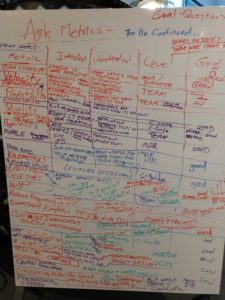“How we deal with death, is at least as important as how we deal with life, wouldn’t you say?”
Admiral Kirk
Have you ever been faced with a concept or idea that just refused to go away? I think my least favorite one is “Service Level Agreement (SLA)”. But right after that one is “Metrics”.
As an Agile Coach, I often encounter requests from clients to provide a list of Metrics. I can hear the collective groans from a lot of you. The funny part is that some of you groaned because you take the position that Metrics mean you can be held accountable (judged), and some of you groaned because you think I’m about to tell you that Metrics are evil.
You’re both right. Kind of.
Let’s come together and agree that Metrics are a necessary evil that can allow us to gauge performance of a system.
BTW, there was a third set of groans. Those groans came from the agile coach in an agile center of excellence who were tasked with creating a list of Metrics for the organization to adhere to. With trepidation in your heart, you presented a simple, standard response… and things went sideways.
Metrics is not an easy subject to discuss in the agile world — partly because Metrics are so prevalent in the non-agile world. It was difficult for agile methods to be adopted in organizations that prided themselves on their ability to measure things. Meaningfully. They demanded the same of the agile insurgency. More’s the pity, because agile cut its teeth by opposing the inappropriate application of those metrics.
Metrics are a tool. I recall a manager at one of my clients adamantly insist that Metrics are just measurements, and measurements are not evil. They are just numbers.
True.
Metrics are tools, and as such are capable of helping us achieve great things. Tools are also capable of causing a lot of damage when that tool is used in the wrong way.
At the Chicago Coaching Summit 2018, held in Chicago this past October, I led an Open Space discussion on Metrics. It was widely attended, and actually extended into a second session. We started our discussion with the premise that the call for metrics was not going to go away, so let’s talk about the metrics we’ve used successfully, and also the ones that we tried to use that led to unexpected outcomes. We decided that Metrics had attributes that we would discuss. We chose:
- Metric Name
- Intended Use
- Unintended Consequence
- Appropriate Level
- Good or Bad?

There was a side conversation that centered around a model of Metrics-building called GQM (Goal, Question, Metric) which centers on the concept that you start with what you want to achieve, what question could you ask to find out if you are achieving it, and measure something that gives you an answer to the question.
The Metrics are summarized in the following link: https://drive.google.com/file/d/1qmyjH3hn8N1Tf0Dn9aTySiqlNXQFuJbI/view?usp=sharing
